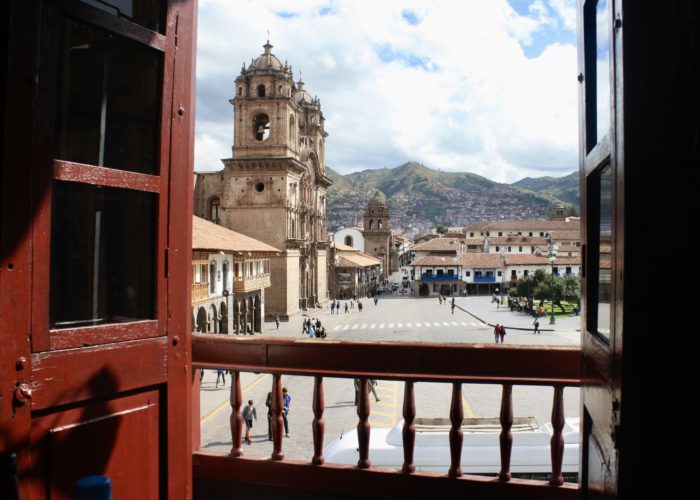We may earn money or products from the companies mentioned in this post. For more information please read our affiliate disclosure
Cusco (Quechua for navel) sits high in the Andes Mountains of South America at an elevation of 11,150ft (3,400m) above sea level. Due to its elevation, Cusco experiences two seasons: rainy season (November-March) and the dry season (April-October). The average temperature of the city sits near 50 degrees Fahrenheit. Key to Cusco’s longevity is the fertile soil of the Sacred Valley that has played a role in its expansion since pre-Inca times! The area where Cusco now sits has been home to many cultures long before the Inca settled the area. Cusco, is in fact, the oldest inhabited city in the Americas! There is evidence of habitation in this area dating back to 1,000 BC! Below I’ll list a few of the major cultures to call this place home. Manco Capac founded Cusco approximately in 1200 AD. He expanded upon the city from the previous inhabitants, the Killke. Cusco became the Capital of the Inca Empire making it the most important city. Part of what made the Inca so successful was taking parts of the cultures they conquered, by war or diplomacy, and integrating them into Inca culture and society. This allowed the people to keep and practice some of their previous beliefs while assimilating into Inca rule. The great Inca Pachacutec greatly expanded upon the layout of Cusco in the 1400’s. He designed the layout of the city to resemble a puma, a very important creature in Inca society. He chose the site of Sacsayhuaman, which he also expanded, as the head of the beast. It was under his rule that Cusco became fitting of the title Capital of the empire! As with all other cultures that formed in this area, agriculture was key to life in Cusco. Some experts suggest that 90% of the Inca residents made their living through farming. The fertile soil of Cusco and the Sacred Valley was why this area could support life for thousands of years. To this day, farming is still an important aspect of life around Cusco. While farming was important, others known to have talents in the crafts were encouraged to develop them. Weaving, ceramics, and metal working were also important to Inca society. Cusco was said to be lined with gold and other precious metals. Typically, children learned the trade of their parents. From an early age, children were expected to help out with the family business. Since only a select few went to school, a child’s education was learning how to work from their parents. In general the men were the laborers on the farms while the women tended to the cooking, cleaning, and raising the children. Both men and women took part in skilled crafts if they possessed the talents for it. However, weaving was typically only done by the women of Cusco. If children showed talents in skills other than those learned from the parents, they too may be trained to build upon these inherent talents. By the time the Spanish arrived to Cusco on November 15, 1533, the Inca Empire was in the middle of a bitter civil war. Two brothers, Huascar and Atahualpa were fighting to control the empire. Backed by the nobility, Huascar controlled Cusco. Seen as a stronger military strategist, Atahualpa controlled Quito in the north. The bitter rivalry and the decimation of the empire from smallpox brought over from Europe, made Cusco prime for the taking when the Spanish arrived. The Spanish found the stories to be true, streets and walls lined with gold and statues of gold and other precious metals as far as the eye could see. Seizing on the distraction the civil war caused, the Spanish took advantage to plunder the treasures of Cusco. Setting traps to capture Atahualpa, they used him to control the Inca citizens while they sent all the treasures back to Spain. On March 23, 1534 Francisco Pizzaro officially claimed Cusco for King Charles V. After this, the city was tore down so they could rebuild it in the catholic style of the times. Cusco lost importance once Pizzaro moved the capital to Lima in 1535. He needed to rule from a city along the coast so he could continue to send the riches of the Inca Empire back to Spain. The location of Cusco high in the Andes Mountains, made it difficult to manage this task. Today, Lima is still the capital of Peru. While many citizens of Cusco still make a living through farming, tourism has really exploded in this city! While Machu Picchu is the major draw to the area, there are many Inca sites to see and Cusco offers a perfect “home base” to explore the area. Whether you like shopping, culture, dining, or outdoor activities, Cusco has a wide range of options for you to enjoy. Cusco has also been honored with several titles in the past few decades. These honors have helped show others that this city is a great travel destination it its own right. With modern influences and glimpses of the past, there is so much to enjoy in and around Cusco. Don’t just bypass this city on your way to Machu Picchu. Take advantage of what this city has to offer as you explore the Sacred Valley! For more information about the Inca and the Sacred Valley click on the link below. As always, thanks for visiting my blog and I hope I’ve helped inspire a future trip to Cusco! trekandteach
Pre-Inca Occupation
Cusco: Founded By The Inca

Daily Life

Spanish Arrival Into Cusco

Present Day Cusco


